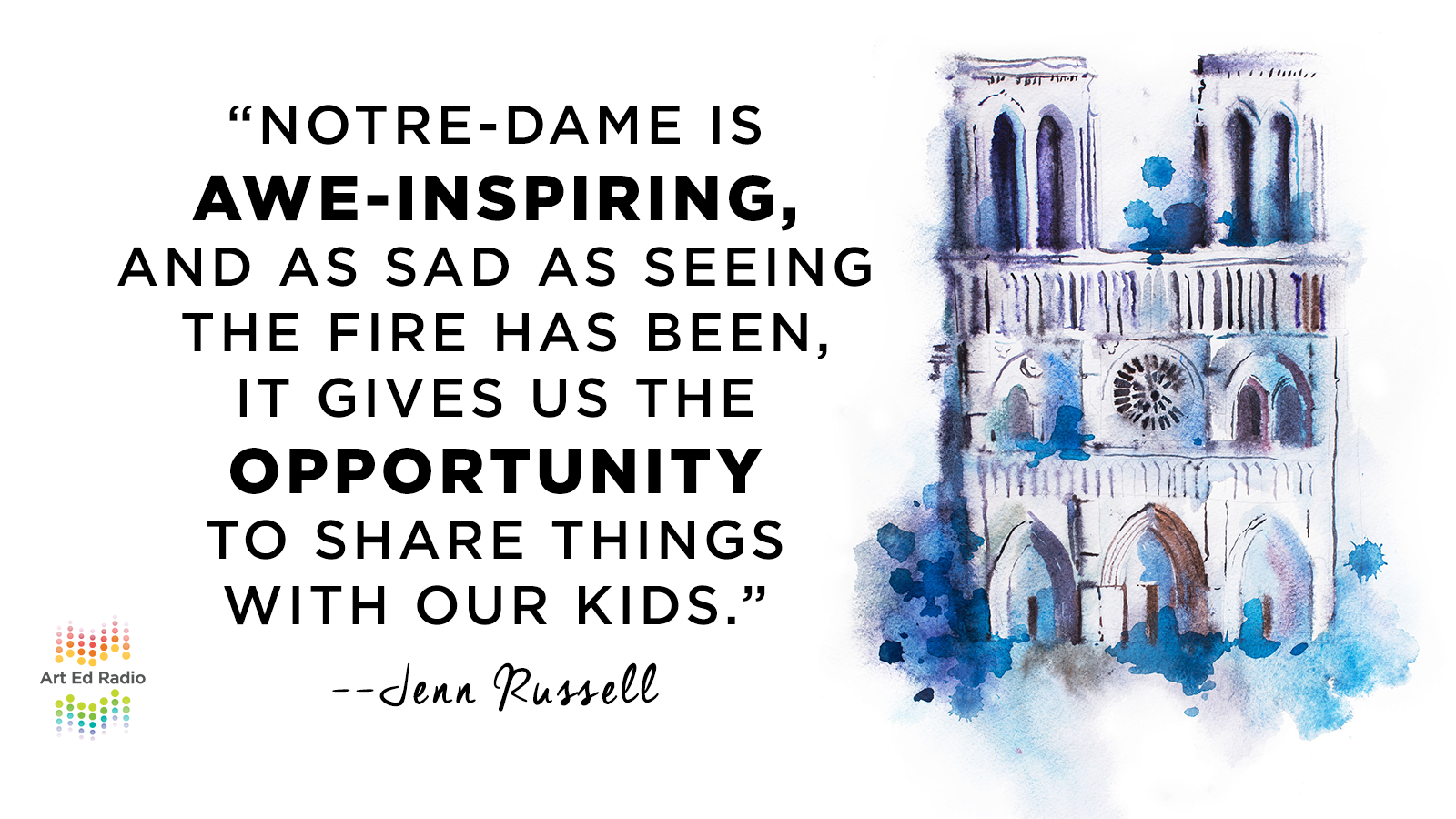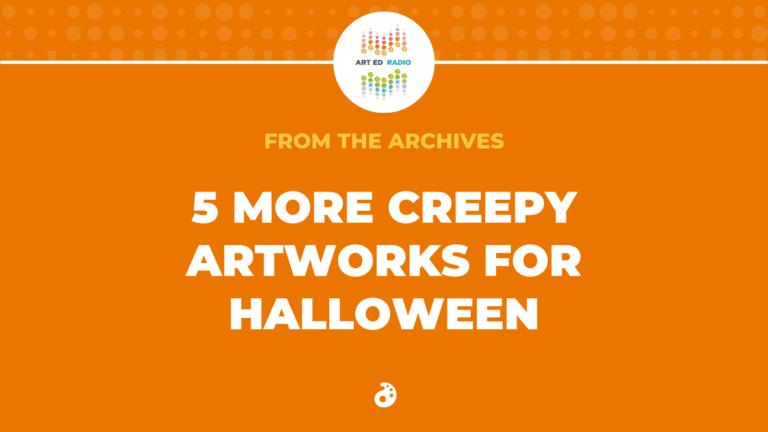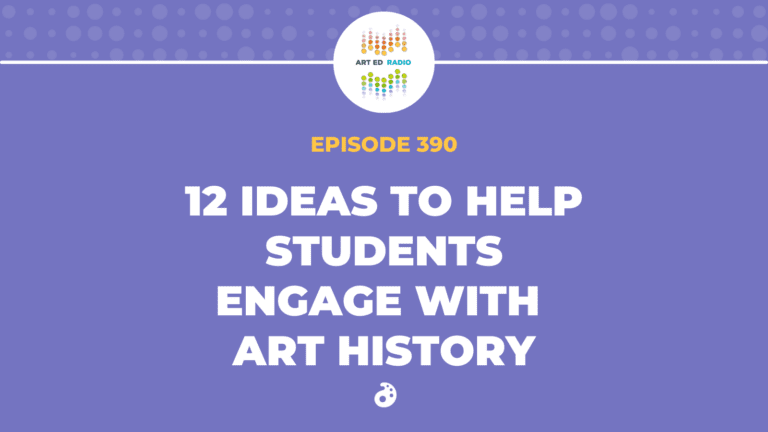After the fire at Notre-Dame last week, Tim takes some time to reflect today on what the cathedral means to art teachers and why we were so affected by seeing it catch fire. Jenn Russell joins Tim to share her experience of visiting the cathedral, how we process this news as art teachers, and how we broach the subject with our students. Full episode transcript below.
Resources and Links
- How Notre Dame Can Be Rebuilt
- Scanning Every Inch of the Cathedral
- A Rundown of the Artifacts Saved and Lost

Transcript
Tim: Welcome to Art Ed Radio, the podcast for art teachers. The show is produced by The Art of Education University, and I’m your host, Tim Bogatz.
Now, we had a pretty good show planned already, but I think it’s worth pushing off for a little bit, because I really do want to talk a little bit and share some thoughts on what happened with the Notre-Dame Cathedral last week.
As everybody saw, a huge fire, and destroyed a significant part of the cathedral, not as bad as we thought it might be. And I think that’s worthwhile, I think that’s something that we need to talk about later as well.
But I want to just kind of dive in and share some of my thoughts, some of my reflections, and talk to somebody about everything that they experienced, and see why it affected art teachers the way it did. That’s the question. Like, why does seeing that fire affect us so much.
And I spent a lot of time thinking about this, and I personally think it’s because we, as art teachers, have a special appreciation for what that cathedral is and what it represents, not only artistically, but architecturally and culturally, because we know the history behind it, we know the effort that went into it. It’s just built by generation after generation of people working their entire life to help construct it, and knowing that they would never see it actually be completed.
And we appreciate that fact, we appreciate that the people who built it were willing to be part of something bigger than themselves. They wanted to be part of something that stood the test of time.
And because we know all that, seeing and knowing about any cathedral, but especially one like Notre-Dame, is meaningful to us. It’s something that is a shared experience. Even if you haven’t been there, as an art teacher, you are familiar with it, and you appreciate it. Everybody here knows its value.
So when you check social media, when you see the news, when you see the cathedral going up in flames, all these emotions come flooding in, and you immediately fear the worst. Like, all of that history, all of that artistry, all of that accomplishment and all of that meaning is going to be lost. This cultural touchstone is about to disappear.
And luckily, like I said, it didn’t come to that, but it’s still something to process, and it’s still something that’s worth thinking about. So I want to talk to somebody about this, not just share all of my own thoughts for 20 minutes here, but I want to hear from somebody who’s been there, who has experienced the cathedral and seen it firsthand, and talk through how they processed the day, what their reactions were and how they’re feeling.
So Jenn Russell’s going to join me today in just a second here. She is a high school teacher near Dallas, Texas. You haven’t heard from her on the podcast here before, but she has a lot to offer, and I’m pretty sure you’re going to be hearing from her a lot more. So today I invited her on, to kind of share her experience, share her thoughts, and we’ll just kind of talk through everything that we’ve been seeing, and thinking, and feeling for the past week or so, so let me bring her on now.
All right, and Jenn Russell is joining me now. Jenn, how are you today?
Jenn: Good. Good, good. How are you?
Tim: I’m doing well. I am excited to talk to you. As I just said, I appreciate the perspective of somebody who’s visited Notre-Dame, who’s been there before. So I just wanted to have a quick conversation with you. And I guess to start out with, can you just kind of tell us your experience with visiting the cathedral, with seeing it for the first time, like what it was like to be there and to take it all in?
Jenn: Yeah. We went in December of 2014. Gosh, this seems like so long ago. But we went and we had no plans for Paris. I just wanted to walk around and kind of get lost, and see what I could see. Of course, you know, all of the major landmarks and the tourist spots, but my mom and my aunt have been talking about just going to Paris my whole entire life, and the dream was to go all three of us, but unfortunately it was just me who made it.
I went and I was just walking around. I stumbled upon the Opera House, and then The Louvre, and a couple of other places, and then we went over I guess the lock bridge, or bridge of love, whatever, the one with all the locks. and then I look up and I’m staring at this massive structure, and I was looking at my husband and I was like, “Oh my gosh, is this it?” And he was like… he’s an engineer. He has no idea what’s going on ever art-wise. But I was like, “Oh my gosh, it’s Notre-Dame. This is it.”
And the first thing you see is the giant rose window, and it’s beautiful and magnificent. And it was in December, so there was this fog with it, and it was in the morning, so it was quiet. During the weekdays it was not a lot of people there. It was the first week of December. And I just left him on the bridge and just started walking.
And I stood in front of it for a long time, and I just couldn’t believe that I made it there. It wasn’t my plan to go, but here we were, in Paris, and I was just staring at this building, who had given me trouble in my art history classes in college, and trying to name all the pieces, and all of the sculptures, and reliefs, and all the things, but I was finally here.
And it was… I don’t know. It was haunting, it was beautiful. Yeah. It was just one of the things that I just will never forget because I was finally here, and just seeing it in real life is just totally different.
Tim: Yeah. That’s amazing. So do you think awe-inspiring would be the right word for that?
Jenn: Definitely. Being an art person, whether or not you teach art history, or you kind of bring it into your classroom if you have time, or just taking a class, I mean, you just know. You know what it is. And then you’re finally seeing it and you’re like, “Okay. Wow. “Here it is. What do I do?”
Yeah. And I asked, I was like, “What am I supposed to do here?” Like, “Can I go in? What do you do?” So I just started snapping a bunch of pictures like a total newb. So yeah, now I have all these awesome pictures of the outside.
Tim: Yeah, that’s really cool. Now, I wanted to ask you to just kind of about your reaction as to what you’re feeling, what you’re thinking when you see it burning? How did you find out that this fire had started, and what was your reaction when you saw that it was burning?
Jenn: Well, we have kind of weird… I mean, I don’t want to say weird, but it’s a different schedule. We’re on accelerated block, so we just have an hour and half on classes, but we switch at the semesters, so this is the end of my second semester. And I just don’t have a lot of time… not even during lunch, because I let my kids eat lunch in my class, so I don’t really browse and cruise as much as I used to when I used to teach at a different school.
But one of my kids was like, “Hey, Russ, did you know that…” first of all he said, “Notre-Dame.” “Notre-Dame is burning down.” And I was like, “what are you saying?” And he’s not the most trustworthy kid, like, “What are you saying right now?” He’s like, “Yeah, Notre-Dame is burning to the ground.”
And I teach high school-ers, juniors and seniors, so they can be a little dramatic. And he’s like, “Yeah, it’s on my iPad,” and he slips it over and lo and behold he’s on CNN and there’s just fire on fire. And I was like, “What is happening?” So I just went to my laptop and I pulled up a bunch of different sites and ABC, and CNN, and there it is. It’s from earlier, whatever, and it had burned and I just was immediately sad.
Anytime that something happens to something historical, but a church, a cathedral, something that has seen things, history, it’s a piece of art, it’s just very different. So I was very sad about it. I was just very, very sad.
Tim: I think that’s kind of the overarching reaction from people, was just sadness, because like you said, this building has seen a lot, it’s been around for centuries, and just knowing that it just stands as a testament to construction, and artistry, and craftsmanship.
Do you think that’s the reason that art teachers reacted the way they did? There’s sadness everywhere, but I feel like it kind of hurt as an art teacher, because we’re losing this history, we’re losing everything that it means, that this cathedral means-
Jenn: Right, and I think… oh no, go ahead.
Tim: I was just going to say, do you think that we have kind of a special connection to the cathedral as art teachers, even if we haven’t visited there? Is it just like the appreciation we have for everything that it represents?
Jenn: I definitely think so. I mean, there are things that double, or that double dip in just different subjects. You know, this is a piece of architecture, and a historical piece, but for me first and foremost, it’s a piece of art. So anytime we lose a piece of art, or it’s… you know, we always watch those videos of the kid bumping into the priceless art piece and then it tears and you’re just like, “Ugh.”
But this one, it belongs to the world. It’s not in a museum, it’s its own museum, and it’s first and foremost a piece of art that belongs to history, that happens to be a building, that happens to have all this historical significance and this architectural prowess, but to me, it will forever be a piece of art.
And that is why I think it hurts a little bit more for us, because we just think of all of the things that are in it. I mean, what would happen if the Sistine Chapel burned down? What’s the first thing you would think about? So it’s kind of the same thing. It’s just all the art that goes with it. To me, it’s first and foremost a piece of art, and everything else secondary.
Tim: Yeah. I think that’s really well-said. And yeah, I think that appreciation we have of everything that goes into it is something that we try and pass on to our kids as well. I wanted to ask you about that too. You talked about eating lunch with your kids. When you’re talking about this, either on that day or in the days after, what do you tell your kids? What is the discussion like in the classroom? How do you share your experience with them? What do you want them to know about it?
Jenn: Well, we talk a lot about… because I have juniors and seniors, and then I have AP, and for us, one thing that I’ve been really grateful is that my AP kids are really, really open, and not only are they open towards what I have to say, but what towards their classmates have to say, and they’re very respectful of just different beliefs and ideas, and ideals, and they’re very… Sorry, my email keeps going off.
They’re very open. And we talked about this, because they were like, “Well, it’s a church, so…” and they were just having a little bit of trouble putting together the idea of can you still appreciate it even if you’re not of the faith? How does that work?” And you go, “But it’s a tourist thing, but…” so they were just kind of having a little bit of trouble reconciling all of that.
So we just talked about it. This is something that… what I said was, “I just feel like…” This was on my list of things to see, and I always encourage them to just have this ongoing list of things that they want to do, and let it be never-ending. And as you cross one off, add another, so that you’re constantly striving towards something. But we talk about it just being something that I’ve always wanted to see, and honor my mom, and to honor my aunt and their struggle to raise kids in a country that wasn’t their own. This was on their list of dreams that I’m fulfilling for them.
But we talked a lot about too just the history behind it and the artistry and just Paris itself, and we did talk a little bit about just faith and how you get there, and could you just go and sit through a Mass, and what would that mean, and how would you feel, and how would you take that in.
So we had a pretty good chat about it. I showed them pictures. Of course, I’m smiling like a loon in all of them. I’m just so dumb excited to be there. Then I took some… because they had it boarded it off, and they were still doing construction on it in 2014, so part of it was boarded off. And I took some zoom in shots of reliefs and things that I had missed on my art history test in college. Like, I could not think of those saints for the life of me.
And we talked about it and we just talked about the fact that this was, for me, more than just a religious significance. It was just a culmination of things that I’ve hearing for my entire life, like I’m telling them. Or they’ve heard of the Mona Lisa for forever and then they finally go see it and they’re like, “She little.” Actually comment from one of my kids, “She real little.” Yeah, you know.
But they’ve been hearing about stuff like this for their entire life just like I’ve been hearing about Notre-Dame. And they take French, and the French teachers were beside themselves, and they teach them how to say it correctly, which I really appreciate.
So I told them, I’m like, “If this is on your list, go see it.” We talked a little bit about religion, but that it’s more of just a religious symbol to a lot of people. Part of the landscape and all of that. So that’s what we talked a little bit about in class.
Tim: I think that’s perfect, because I think a lot of teachers are kind of searching right now on how to talk about it, what to discuss to their students. It’s part of the reason I went in to chat about this with you, but just being able to kind of share your experience with us, and being able to help us to put all of this in context so I think it’s really appreciated.
So we’ll tell you thank you, Jenn, and it was great to talk to you, and we hopefully can have you back on the show again soon.
Jenn: Yeah, thank you so much for having me.
Tim: All right. Thank you to Jenn for coming on and giving us her perspective, just kind of talking things out with me, which is really all I wanted to do.
And to wrap things up, I guess I want to look at the positive side of things, because that’s just kind of how I am personally, and I think there is a lot to be positive about as scary as it was to see things go up in flames. And like I said, we start to immediately fear the worse. But as things settle down and we get a clearer view of everything that’s going on there, there is a lot to be positive about.
The rose windows, the amazing stained glass survived. A lot of the sculptures, the artwork, the altar, were all saved, and there is some great stories about exactly what they did to get all of the artwork out, get it into a safe space. And I think being able to hear about that is a very, very positive thing.
And I think looking forward into the future is another reason to be positive. Just the pride that the French people take in preserving their culture I think is amazing. And ever since the last time the cathedral was damaged, they’ve had plans to rebuild.
And one thing that I think is really fascinating is hearing about the trees that they planted at Versailles, because with the cathedral, it’s originally build with these really, really tall centuries-old oak trees. And they need to do oak because the stone the cathedral’s built with is not made to support all of this weight, so even if they were to try and redo the roof with steel or any other kind of modern materials, the walls can’t support that.
So they have planted these trees as Versailles, these oak trees, for the past couple hundred years, and they’re ready to rebuild right now, which is kind of me going off on a tangent, but just saying they’re prepared for this. And they are ready to put things back together, which I think is really positive.
And another fascinating story that I read is all about how these historians, and a couple in particular, have tried mapping all of these cathedrals, and they have been able to just take literally billions of data points, to put together exact measurements for the cathedral from everything, floor to ceiling, wall to wall, everything in between, and that’s going to be a huge help as they begin to rebuild.
And finally, donations have come in from across the world. They’re going to have all the money they need to put everything back together, to rebuild Notre-Dame, which I think is a really positive thing.
And then just a couple last thoughts before I close it out here. There are a lot of good ways to discuss this with your kids, maybe you’ve done this already, maybe you want to continue on, maybe it’s something that you want to put into your curriculum for next year. There are a lot of incredible 360 degree virtual tours of Notre-Dame, where you can just go through the whole cathedral and see everything that’s there. And I think kids are always fascinated by that, and I think that’s a good place to start.
And secondly, if you’re looking for a way to open up the discussion about how these are built and just the massive undertaking that it is, I actually stole this from my wife who’s a history teacher, when she talks about it and then when I was talking about it in my classroom, she always has this great anticipatory set that asks kids, “Would you be willing to spend your entire life working on a project that you would never see finished?”
And she doesn’t tell them what it’s about, but she has them right a little bit to kind of get kids interested and kind of intrigued about what’s going on, and it opens up the discussion on everything that goes into building a cathedral and just the massive amounts of time, and effort, and resources that go into those, and really kind of helps kids appreciate exactly what they’re seeing there. And I think that’s something worthwhile that we can take into our class.
And then one last thing, and then we’ll go ahead and wrap things up. Just on a personal note, I love the book Pillars of the Earth by Ken Follett. It’s a great fictional story about building cathedrals in the Middle Ages and moving from Romanesque architecture into Gothic architecture.
And there’s a lot of superfluous drama perhaps that goes into the story, but it makes it a really good read, and there’s a lot there about building cathedrals, people’s motivations, and all of the massive efforts and undertaking that really makes you appreciate that. So if you’re looking for a good read, check out Ken Follett with Pillars of the Earth.
Okay. I think that’s about all I need to talk about here. Anyway, I think it was worth doing an episode on this massive news story, and it’s worth thinking about how we talk about these things with our kids. So hopefully this is helpful, hopefully this helps you reflect and hopefully this episode can give you some ideas on how to bring this into your classroom a little bit more, and then next week we’ll be back to our regular schedule. So anyway, thanks for listening this week, and we will talk to you again soon.
Art Ed Radio is produced by The Art of Education University with audio engineering from Michael Crocker. As I just said, thank you as always for listening, and we will be back next week.
Magazine articles and podcasts are opinions of professional education contributors and do not necessarily represent the position of the Art of Education University (AOEU) or its academic offerings. Contributors use terms in the way they are most often talked about in the scope of their educational experiences.



